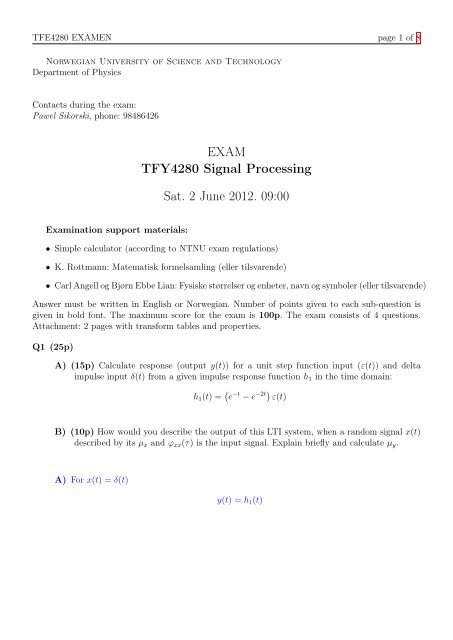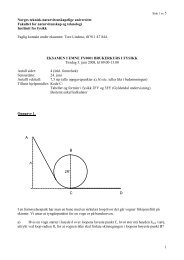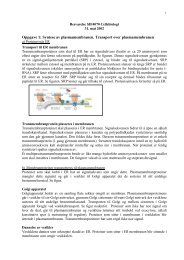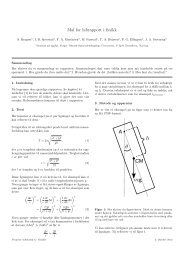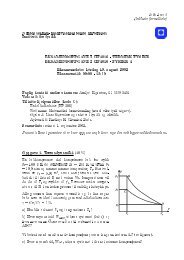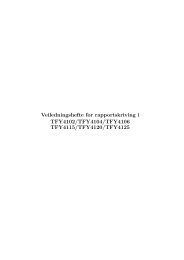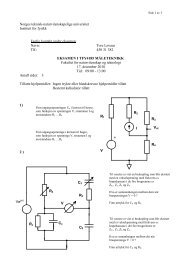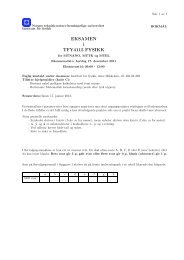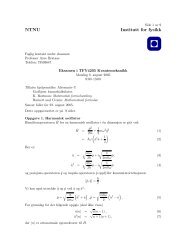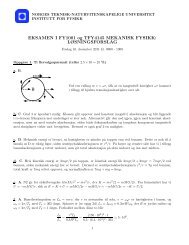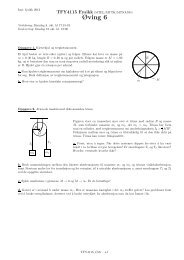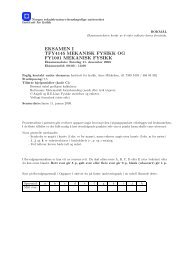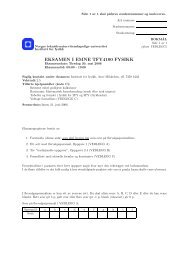EXAM TFY4280 Signal Processing Sat. 2 June 2012. 09:00 - NTNU
EXAM TFY4280 Signal Processing Sat. 2 June 2012. 09:00 - NTNU
EXAM TFY4280 Signal Processing Sat. 2 June 2012. 09:00 - NTNU
Create successful ePaper yourself
Turn your PDF publications into a flip-book with our unique Google optimized e-Paper software.
TFE4280 <strong>EXAM</strong>EN page 1 of 8Norwegian University of Science and TechnologyDepartment of PhysicsContacts during the exam:Pawel Sikorski, phone: 98486426<strong>EXAM</strong><strong>TFY4280</strong> <strong>Signal</strong> <strong>Processing</strong><strong>Sat</strong>. 2 <strong>June</strong> <strong>2012.</strong> <strong>09</strong>:<strong>00</strong>Examination support materials:• Simple calculator (according to <strong>NTNU</strong> exam regulations)• K. Rottmann: Matematisk formelsamling (eller tilsvarende)• Carl Angell og Bjørn Ebbe Lian: Fysiske størrelser og enheter, navn og symboler (eller tilsvarende)Answer must be written in English or Norwegian. Number of points given to each sub-question isgiven in bold font. The maximum score for the exam is 1<strong>00</strong>p. The exam consists of 4 questions.Attachment: 2 pages with transform tables and properties.Q1 (25p)A) (15p) Calculate response (output y(t)) for a unit step function input (ε(t)) and deltaimpulse input δ(t) from a given impulse response function h 1 in the time domain:h 1 (t) = ( e −t − e −2t) ε(t)B) (10p) How would you describe the output of this LTI system, when a random signal x(t)described by its µ x and ϕ xx (τ) is the input signal. Explain briefly and calculate µ y .A) For x(t) = δ(t)y(t) = h 1 (t)
TFE4280 <strong>EXAM</strong>EN page 2 of 8For x(t) = ε(t) we need to find Laplace transform of h 1 (t):L {h 1 (t)} = L { ( e −t − e −2t) ε(t)} = 11 + s − 1s + 2 = s + 2 − s − 1(s + 1)(s + 2) = 1(s + 1)(s + 2)Y (s) = H(s)X(s) =0.5s − 1(s + 1) + 0.5(s + 2)X(s) = 1 s1s(s + 1)(s + 2) = A s + B(s + 1) + Cs + 2A = 1 2B = −1 C = 1 2check:0.5(s + 2)(s + 1) − s(s + 2) + 0.5s(s + 1)= =s(s + 1)(s + 2)0.5s 2 + 3/2s + 1 − s 2 − 2s + 0.5s 2 + 0.5ss(s + 1)(s + 2)=1s(s + 1)(s + 2) OK!Then:Y (s) = 0.5s − 1(s + 1) + 0.5(s + 2)y(t) = ε(t) ( 0.5 − e −t + 0.5e −2t)B) For random signal, first we consider what happens with the meanh 1 (t) = ( e −t − e −2t) ε(t)y(t) = x(t) ∗ h 1 (t)µ y (t) = E{x(t) ∗ h 1 (t)} = E{x(t)} ∗ h 1 (t) = µ x (t) ∗ h 1 (t)since(time independent)∫∞µ y = µ xh 1 (t)dt = µ x∫∞µ x (t) = µ x(e −t − e −2t) ∫∞ε(t)dt = µ x(e −t − e −2t) dt = 0.5µ x−∞For the ACF:−∞ϕ yy (τ) = ϕ hh (τ) ∗ ϕ xx (τ)ϕ hh (τ) = h 1 (τ) ∗ h 1 (−τ)0Where ϕ hh (τ) can be calculated from analytical expression for h 1 .Q2 (25p) Consider LTI system described by:[ d2dt + 5 d ]2 dt + 4 y(t) =[2 d ]dt + 6 x(t)A) (10p) Find the impulse response h(t)
TFE4280 <strong>EXAM</strong>EN page 3 of 8B) (10p) Find the unit step response s(t) by using ɛ(t) as inputC) (5p) Verify your result by showing that h(t) = d dt s(t)A) We will first find the system transfer function H(s) by taking the Laplace transform of thegiven ODE,( d2dt + 5 d )2 dt + 4 y(t) =(2 d )dt + 6 x(t)⇒(s 2 + 5s + 4)Y (s) = (2s + 6)X(s).Transfer function and its partial fraction expansion (verify!) isH(s) = Y (s)X(s) = 2s + 6s 2 + 5s + 4 = 2s + 6(s + 1)(s + 4) = 4 3Thus the impulse response ish(t) = L −1 {H(s)} = 2 3(2e −t + e −4t) ɛ(t)1s + 1 + 2 13 s + 4B) Laplace transform of the unit step input is X(s) = 1/s. The output of the system in theLaplace domain is given byY (s) = H(s)X(s) =2s + 6 1(s + 1)(s + 4) s = 3 12 s − 4 3Inverse transforming gives the time-domain response,[ 3y(t) =2 − 4 3 e−t − 1 ]6 e−4t ɛ(t)1s + 1 − 1 16 s + 4C) For t > 0 we get (othewise we have to differentiate ɛ(t)),(dy(t) 4=dt 3 e−t + 4 )6 e−4t · 1 = 2 3 (2e−t + e −4t ) = h(t)Q3 (25p) Explain the difference between FT, DFT and DTFT with respect to time domain signalsfor which those are calculated and resulting frequency representations. In a frequency rangeω = 2π ∈ [−30, 30], sketch approximate absolute values of FT, DTFT and DFT of a signalfdefined by:y(t) = e −a2 t 2for a = 2s −1 and, where necessary, using sampling time t s = 0.25s and signal duration t ∈[−3, 3].HINT:F s (ω) = 2πω s∞∑n=−∞F (ω − nω s )
TFE4280 <strong>EXAM</strong>EN page 4 of 8x(t) & x[n*ts]1|FT|1|DTFT| for t s= 0.250.9|DFT| for t s= 0.25 and t [−3, 3]10.90.90.80.80.60.40.20.80.70.60.50.40.30.20.80.70.60.50.40.30.20.70.60.50.40.30.2<strong>00</strong>.10.10.1−3 −2 −1 0 1 2 3t0−20 0 20ω0−25.1327 0 25.1327ω0−25.1327 0 25.1327ωFigur 1: Question Q3FT√ πF (0) =2{Y (jω) = F e −a2 t 2} √ π=√ π2 e−1 F (8) =F (4) =a e −ω24a 2√ π2 e−4and here x(t) is continius and defined for t ∈ [−∞, ∞]. Resulting transform is continiusin ω and also defined for ω ∈ [−∞, ∞].DTFT Here the time domain signal is discreet, t ∈ [−∞, ∞], the resulting transform is continuesin frequency, and periodic with a period ω s , ω ∈ [− ωs , ωs ] 2 2ω s = 2πt s= 2π0.25 = 8πF s (ω) = 2πω s∞∑n=−∞F (ω − nω s )DFT Both periodic and discreet in time domain and in the frequency domain. To calculatewe need to define time domain periodicity of the signal:t = −3 : 3 sL = 6/0.25 = 24DFT is periodic with a frequency ω = ω s and defined at points in the frequency spaceω s k/L where L is the length (periodicity) of the signal in the time domain.Q4 (25p) The figure below (Figure 2) shows a digital filter (DSP) in which the delays are 0.5 ms.A) (10p) Write down the difference equation and from this derive Z-transform of the transferfunction. Using a method of choice, analyse the system and calculate 5 first output terms(0 ≤ n < 5) for the unit step excitation and α = 0.1535. What kind of filter is this?
TFE4280 <strong>EXAM</strong>EN page 5 of 8x[n]α1y[n]t s(1 − α)Figur 2: Question Q4B) (15p) Now you would like to design an analogue 1st order Butterworth filter (using onecapacitance C and one resistance R = 1<strong>00</strong>0Ω) with approximately the same frequencyresponse. Determine needed capacitance C and plot filter circuit diagram.HINT Derive expression for inpulse response of the DSP and Butterworth filters. For filterswith similar frequency response, the inpulse respons function will depend on time in thesame manner (h(t)/h(0) = h[n]/h[0]). This also maight be useful:a n = ( e β) nt = n · t sA)For our filter we can write the difference equation as:ln a = βFor unit step response:and theny[n] = αx[n] + (1 − α)y[n − 1]Y (z) = αX(z) + (1 − α)Y (z)z −1αzH(z) =z − (1 − α)X(z) =zz − 1Y (z) = H(z)X(z) =αzz − (1 − α) · zz − 1y[n] = [0.1535 0.2834 0.3934 0.4865 0.5654 ]y[n] = 1 − (1 − α) n+1 n ≥ 0B)DSP filters inpulse response can be calculated directly from its z-transformαzH(z) =z − (1 − α) = α zz − (1 − α)h[n] = α(1 − α) n n ≥ 0h[n] = α(1 − α) n = α ( e β) n1 − α = e ββ = ln(1 − α)h[n] = αe ln(1−α)n = 0.1535e −0.1667nFor α = 0.1535, β = −0.1667. Now we need impulse response for a first order Butterworth lowpass filter.
TFE4280 <strong>EXAM</strong>EN page 6 of 8++v i (t)R 1 iC v o (t)−−Figur 3: Circuit diagram for Butterworth low pass filterH(s) =11 + sRC = 1/RCs + 1RCh(t) = ω c e −tωc= ω cs + ω cNow we just have to compare time constant in both impulse response functionsAt t = 1 · t s , n = 1 and:or simpler:h(t) = ω c e −tωch(t s ) = ω c e −tsωch[n] = αe ln(1−α)nh[1] = ae ln(1−α)1t s ω c = − ln(1 − α)t sRC1RC= − ln(1 − α)=− ln(1 − α)t st sRC =− ln(1 − α)C =t s− ln(1 − α)RC = 3 × 10 −6 Fh(t)h(0)= h[n]h[0]e ln(1−α)n = e −tωc=0.5 × 10−3.167 · 1<strong>00</strong>0ln(1 − α) = − t n ω c = t s ω c−ln(1 − α)t s= ω c
TFE4280 <strong>EXAM</strong>EN page 7 of 8
TFE4280 <strong>EXAM</strong>EN page 8 of 8


